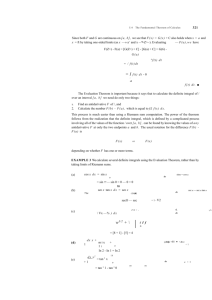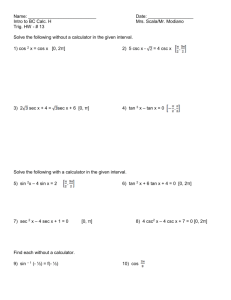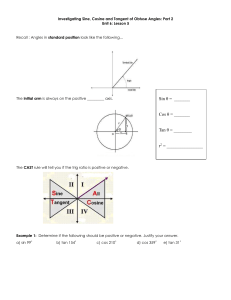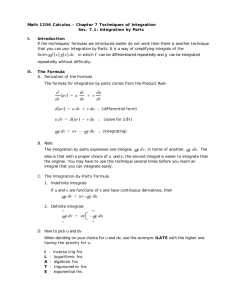Section 4.5 * Integration by Substitution
advertisement
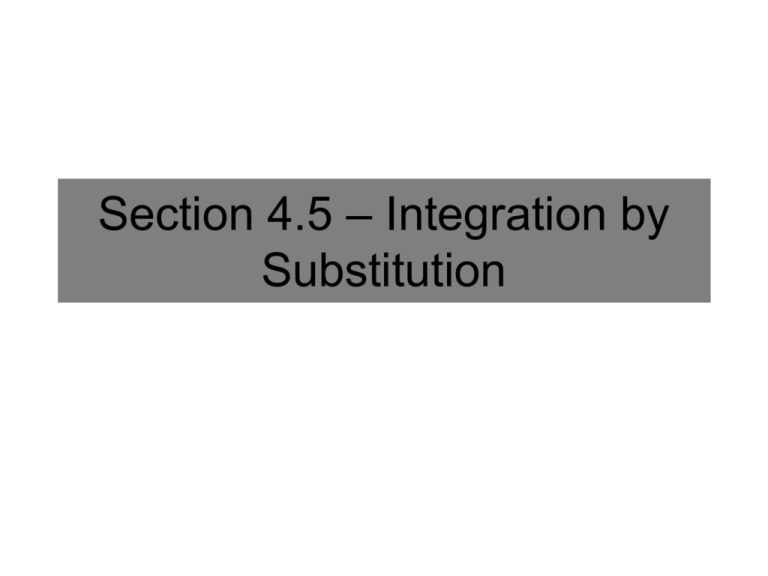
Section 4.5 – Integration by Substitution The Chain Rule and Integration Find F' x if F x x 3x 5 . f u u 9 2 u x 3x 5 2 9 f ' u 9u 8 u' 2 x 3 F ' x f ' u u ' 9u8 2 x 3 9 x 3 x 5 2 x 3 2 8 THUS: 2 9 x 3x 5 u 2 x 3 dx x 8 du 2 3x 5 C 9 Integration by Substitution Let f, g, and u be differentiable functions of x such that f x g u du dx Then f x dx g u du dx dx g u du G u C where G is an antiderivative of g. Substitution Guidelines 1. Choose a substitution u = g(x). Usually, it is best to choose the inner part of a composite function, such as a quantity raised to a power. 2. Compute du = g '(x)dx. 3. Rewrite the integral in terms of u. Make sure every x and dx is no longer in the integral. 4. Find the resulting integral in terms of u. 5. Replace u by g(x) to obtain an antiderivative in terms of x. 6. If you have a definite integral, make sure you change the limits of integration to be in terms of u before you integrate. Example 1 Find 9 x 3x 5 2 Define u and du: 2 x 3. dx 8 u x 2 3x 5 du 2x dx 3 dx du 2 x 3 dx Substitute to replace EVERY x and dx: 9 x 3x 5 2 x 3 dx 9 u du 2 8 8 9 u du 8 Integrate. 9 811 u 81 C Substitute back to Leave your answer in terms of x. u9 C x 3x 5 C 2 9 Example 2 Find xx 2 7 dx . Define u and du: 5 u x2 7 du 2x dx 1 2 x du dx Substitute to replace EVERY x and dx: xx 2 Solve for dx 7 dx x u dx 5 5 x u 5 1 2x Substitute back to Leave your answer in terms of x. 1 2 u 5 du du Integrate. 12 511 u 51 C 121 u 6 C 1 12 x 2 7 C 6 Example 3 Find 1 cos 2 2 x dx Define u and du: sec 2 2x dx Rewrite u 2x du 2 dx 1 2 du dx Substitute to replace EVERY x and dx: sec 2 sec u dx sec u du sec u du 2x dx 2 2 Substitute back to Leave your answer in terms of x. 1 2 1 2 2 12 tan u C 12 tan 2x C Solve for dx Integrate.` Example 4 Find x 5 x 1 dx . u 5x 1 1 5 u 1 x du 5 dx 1 Solve for 5 du dx Define u and du: dx Substitute to replace EVERY x and dx: x 5 x 1 dx Integrate. x u dx x u 15 du 15 u 1 u 15 du 1 25 1 25 1 25 There is still an x. Solve the initial equation of u for x. 12 u 1 u du Substitute back to Leave your answer in terms of x. 32 12 u u du 2 5 u 52 u 2 3 32 C 5x 1 2 125 52 2 75 5 x 1 32 C Example 5 Find F(x) if F(0.5) = 4 and F ' x 4 x 1 . Define u and du: u 4x 1 du 4 dx 1 4 du dx Substitute to replace EVERY x and dx: u u u 4 x 1 dx 12 dx 12 1 4 12 1 4 1 4 1 1 2 1 Solve for dx Find C: du du 1 2 1 u C 16 u 3 2 C 1 6 4 x 1 32 C F x 1 6 4 1 6 4 x 1 32 C 4 0.5 1 32 C 4 16 C 23 6 C F x 1 6 4 x 1 32 236 Example 6 5 8 Evaluate Define u and du: 4 cos 2x dx x 5 8 x 4 u 2x cos 2 x dx Change the Limits: du 2 dx Substitute: 5 8 4 cos 2x dx 5 4 2 Path 1: cos u 5 4 1 2 2 1 2 x 4 x 58 2x 2 2x 54 u 2 u 54 du 2 1 2 cos u du 5 4 sin u 2 sin 54 sin 2 Path 2: 1 2 2 4 12 sin 2x 5 8 4 1 2 sin 2 sin 2 5 8 2 4 12 4 Example 7 Evaluate 4 0 Define u and du: tan x sec x dx 2 x 0 u tan x du sec x dx Substitute: 0 tan x sec 2 x dx tan x sec 2 x dx x x0 4 tan x tan 0 tan x tan 4 u0 u 1 Change the Limits: 2 4 x 4 1 0 Path 1: u du 1 11 u u 1 2 1 2 11 1 2 1 0 0 12 12 02 Path 2: 1 2 2 tan x 12 tan 1 2 1 2 4 0 2 4 12 tan 2 0 White Board Challenge Evaluate: 5 0 x 25 x dx 2 125 3 Integration of Even and Odd Functions Let f be integrable on the interval [-a,a]. 1. If f is an even function, then a a f x dx 2 f x dx a 0 -a a Integration of Even and Odd Functions Let f be integrable on the interval [-a,a]. 2. If f is an odd function, then a a -a f x dx 0 a
